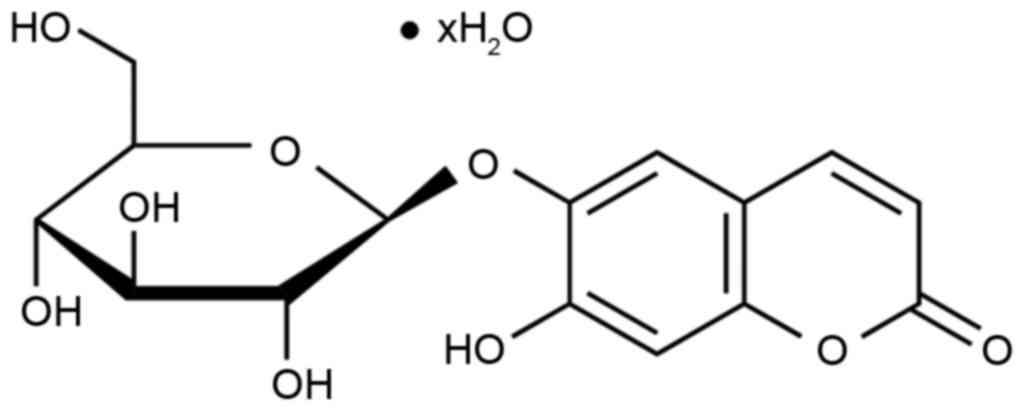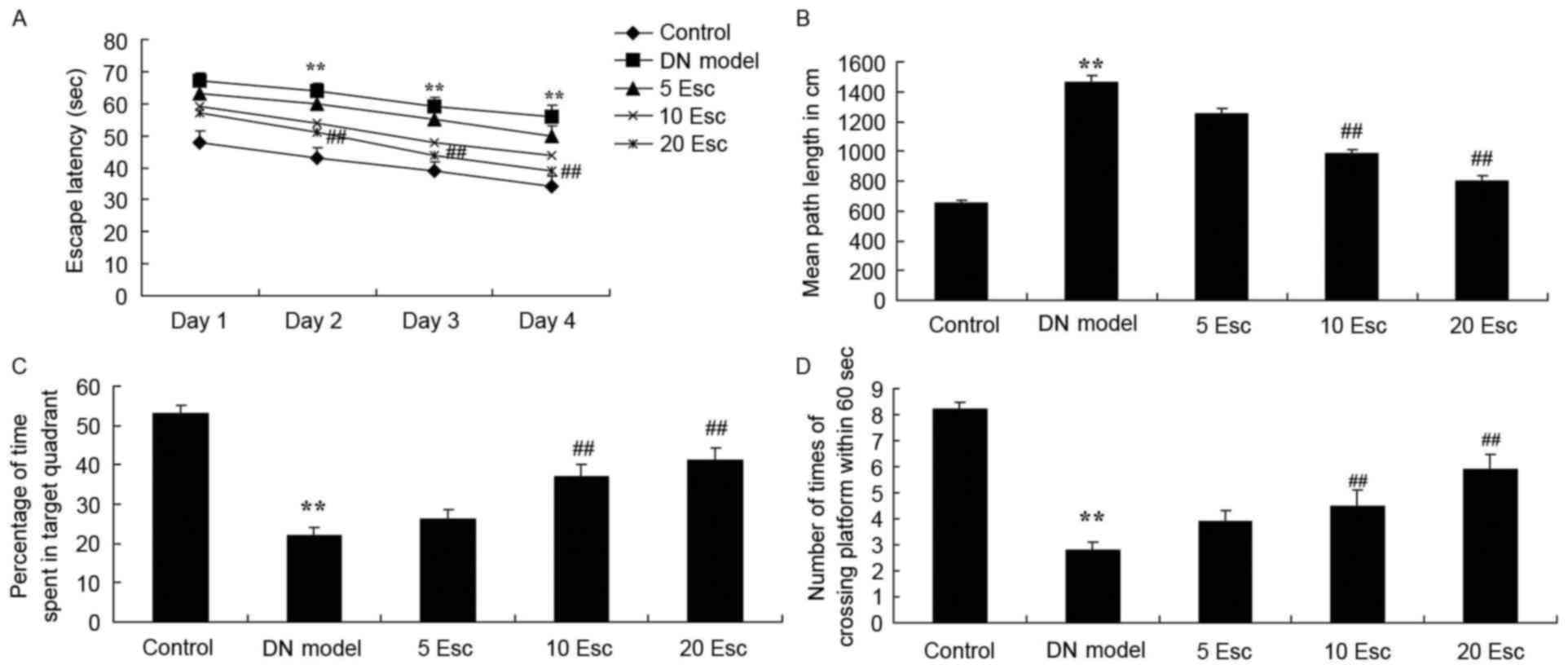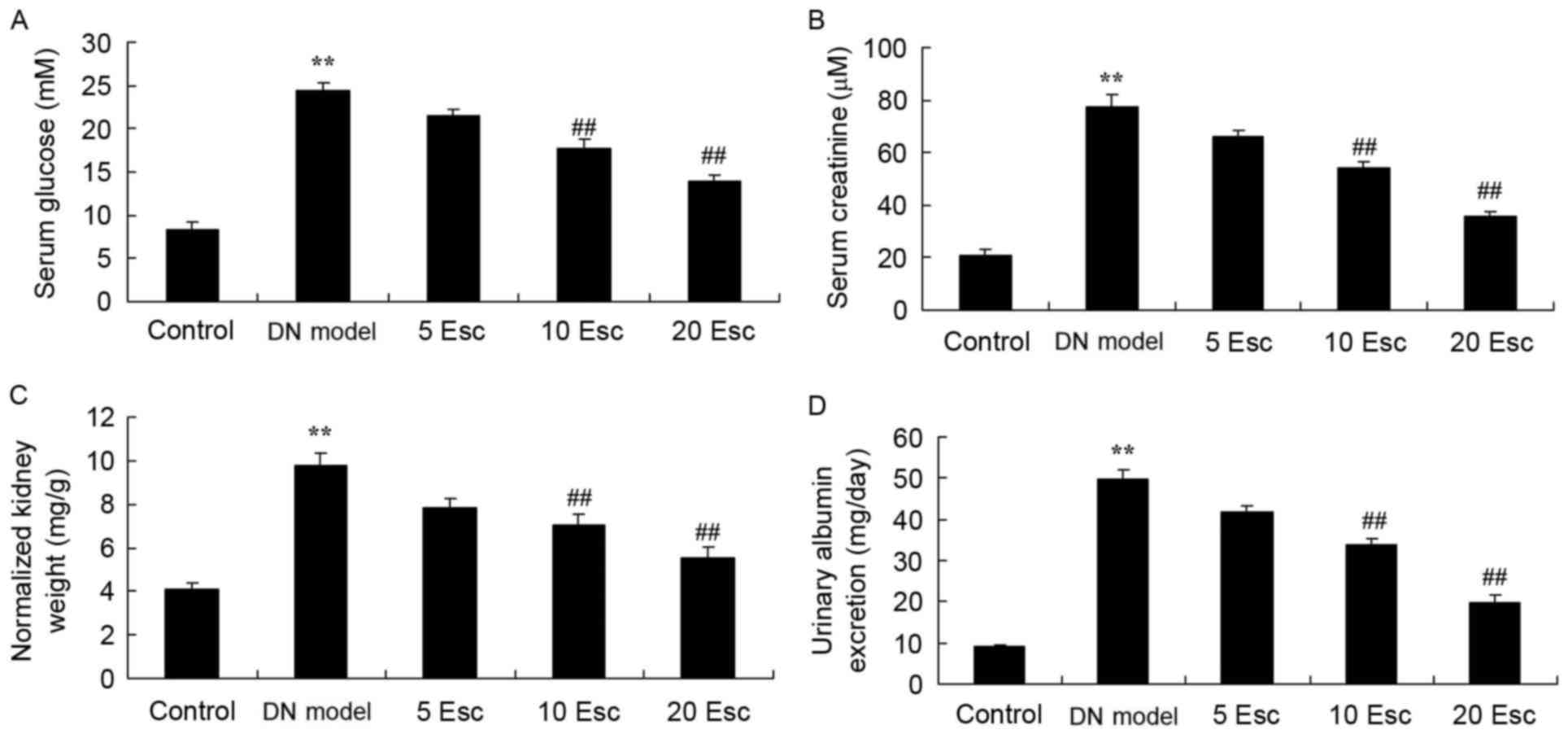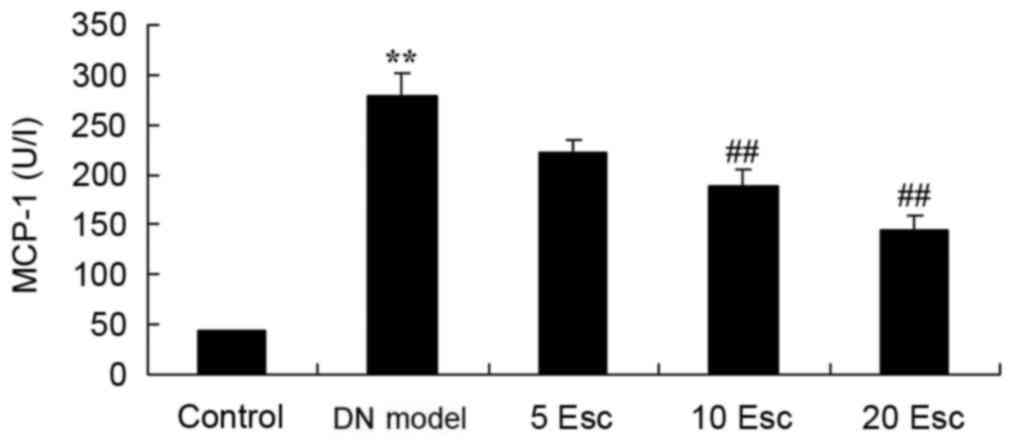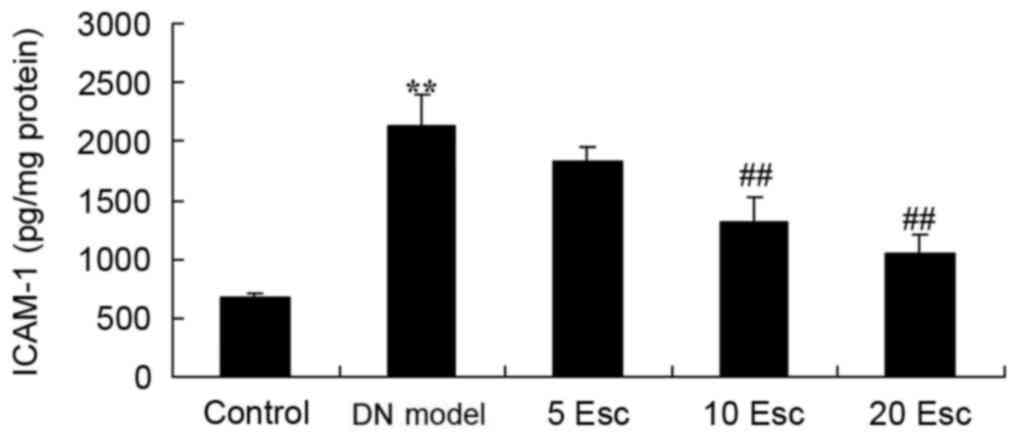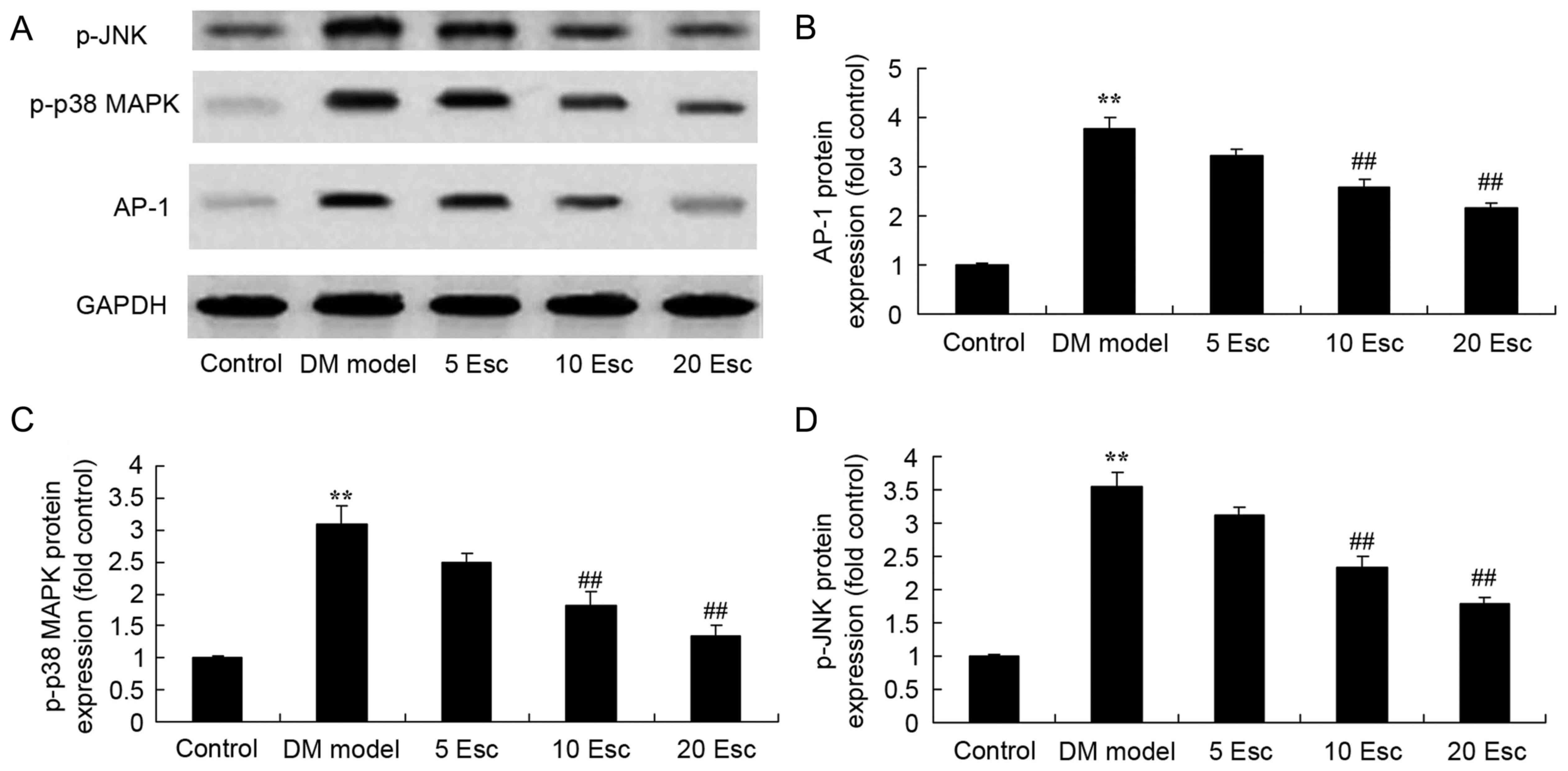Esculin ameliorates cognitive impairment in experimental diabetic nephropathy and induces anti-oxidative stress and anti-inflammatory effects via the MAPK pathway
- Authors:
- Published online on: March 13, 2018 https://doi.org/10.3892/mmr.2018.8727
- Pages: 7395-7402
Abstract
Introduction
With the rapid development of the global economy and alterations to lifestyles and diet, the prevalence of diabetes in the population is rapidly growing. In 2008, the prevalence of diabetes in China was 9.7%; in 2010, it was reported that the diabetic rate had increased to 11.7% following the introduction of the glycated hemoglobin diagnostic criteria by the Chinese Center For Disease Control And Prevention, based on the original diagnosis of diabetes, with a total number of ~113 million cases (1). It is estimated that the total number of patients with diabetes in China may be the highest globally. Diabetic nephropathy (DN) is a microvascular disease caused by diabetes, which is difficult to cure and may have a serious impact on the lives of patients (2). Research has demonstrated that DN eventually develops into end-stage renal disease (3).
Cognitive ability refers to the ability of an organism to perceive the surrounding environment, which is also the basis for addressing and resolving issues, and typically includes memory, attention, learning ability, abstract and comprehensive analysis capabilities, information processing speed, problem-solving ability and psychomotor speed (4). Impaired cognition is considered to be the result of ≥1 of these aspects being impaired, and ranges from mild cognitive impairment to severe dementia (5). Cognitive impairment is a transitional stage between normal aging and dementia, which is a clinical syndrome (6). In 2010, a study demonstrated that the cognitive impairment prevalence was 20.8% in the community population of individuals >65 years old, with the total number of affected individuals being ~23.86 million in China (7).
Oxidative stress is an important factor that leads to nerve cell damage. Abnormally deposited Aβ may induce oxidative stress, and lead to the loss of synaptic function and hindered neuronal metabolism, which serves a key role in the pathogenesis of cognitive impairment (8). Following injection of amyloid-β (Aβ) into the temporal lobe cortex of rats, it was reported that the oxidative stress level was increased in brain tissue, neurons were injured and the number of activated astrocytes was significantly increased (9). Additional experimental results revealed that there is a positive association between cognitive impairment and oxidative stress, for example, Aβ deposition in the brain may lead to the generation of oxidative stress, and oxidative stress also promotes Aβ deposition in the brain, reducing its clearance rate and thereby speeding up the progression of cognitive impairment (10).
Previous studies concerning the pathogenesis of DN have demonstrated that multiple factors, including abnormal gene regulation, inflammation, oxidative stress, an abnormal endoplasmic reticulum system, accumulation of advanced glycation end-products, polyol and activation of protease C, are involved in the occurrence and development of diabetic nephropathy (11,12). These processes are all inextricably associated with the local microinflammation of the kidney (12).
Mitogen-activated protein kinases (MAPKs) are widespread in vertebrates. The MAPK signaling pathway is an important eukaryotic signal transduction network and serves a key role in the gene expression regulation process (13). MAPK contains three classic subfamilies, including extracellular regulated kinase (ERK) 1/2, p38 MAPK and c-Jun N-terminal kinase (JNK) (13). Certain studies have revealed that the activities of p38 MAPK and JNK are significantly increased in kidney tissues with DN, indicating that the MAPK signaling pathway is closely associated with DN (14,15).
Esculin is a derivative of coumarin, which is also an active ingredient of ash bark, and has antibacterial, anti-inflammatory, anti-allergy and skin protective effects (16,17). In addition, esculin was reported to treat increased capillary fragility and prevent peripheral vascular diseases (18). Esculin exhibits various activities, including anti-inflammatory, antibacterial, anticoagulation and analgesic effects, and has a significant diuretic effect in mice (18). In addition, esculin inhibits aldose reductase in the rat eye lens, serves as a growth inhibitor of Bacillus subtilis (19). The present study aimed to determine whether esculin may ameliorate cognitive impairment in experimental DN and to determine the potential underlying mechanisms.
Materials and methods
Animals, DN model and study design
Experiments were performed in accordance with the Guide for the Care and Use of Laboratory Animals of the First Affiliated Hospital of Harbin Medical University (Harbin, China), and were approved by the ethics committee of the First Affiliated Hospital of Harbin Medical University. Male C57BL/6J 6-week-old mice (20–22 g, n=38) were obtained from the Animal Laboratory of Harbin Medical University and housed in cages under controlled environmental conditions (23–24°C, 55–60% humidity, 0.038% CO2 and a 12 h light/dark cycle) and allowed freely access to food and water. Following acclimatization for one week, the mice were randomly divided into five groups: Control (n=6), DN model (n=8), 5 mg/kg esculin (n=8), 10 mg/kg esculin (n=8) and 20 mg/kg esculin (n=8). Mice from the DN model group, and 5, 10 and 20 mg/kg esculin groups, were injected intravenously with a single low dose of streptozotocin (30 mg/kg; STZ; Sigma-Aldrich, Merck KGaA, Darmstadt, Germany). In control group, mice were injected intravenously with normal saline. At 2 weeks after STZ injection, mice from the DN model group, and 5, 10 and 20 mg/kg esculin groups, were injected intravenously with normal saline, or 5, 10 or 20 mg/kg esculin for two days for 2 weeks. Following this, mice were subjected to functional analysis tests, such as the Morris water maze test and assessment of biochemical and urine parameters.
Morris water maze (MWM) test
Briefly, the MWM test for mice consisted of a stainless-steel circular tank (diameter, 90 cm; height, 50 cm). It was painted white on the inside and a circular platform of 9 cm in diameter was submerged 0.5–1 cm below the surface of water (28–32°C). The tank was divided into four quadrants and the end of each line marked four cardinal points: North, south, east and west. The maze was placed in water at 37°C, and mice placed in it were observed. The experiment began by lowering the animals into the pool and releasing them into the water at water-level (not dropped) so that they were facing and close to the side wall for 60 sec. The latency and swimming distance were recorded. Subsequently, mice were placed on the platform for 20 sec, and next training was performed following 60 sec of rest. This experiment was repeated six times and each day was recorded. On day 5 of the training, the platform was removed, and the number of crossings of the platform location within 120 sec (crossing number) was recorded.
Assessment of biochemical parameters and urine parameters
Serum samples were collected after centrifugation at 1,000 × g for 10 min at 4°C to determine glucose levels (cat. no. F006) using ELISA KITS according to the manufacturer's protocol of each kit (Nanjing Jiancheng Bioengineering Institute, Nanjing, China). Urine was collected to measure urinary albumin excretion (cat. no. C035-2) and serum creatinine (C012-1) using ELISA KITS according to the manufacturer's protocol of each kit (Nanjing Jiancheng Bioengineering Institute, Nanjing, China).
Determination of tumor necrosis factor (TNF)-α, interleukin (IL)-6, superoxide dismutase (SOD), malondialdehyde (MDA), monocyte chemoattractant protein (MCP)-1 and intracellular adhesion molecule (ICAM)-1 levels
A total of 50 mg right kidney tissue of mice was precisely weighed and normal saline (1:9 w/v) was added to kidney tissue samples. The kidney was homogenized and centrifuged at 6,000 × g for 10 min at 4°C. The levels of TNF-α (cat. no. H052), IL-6 (cat. no. H007), SOD (cat. no. A001-1-1), MDA (cat. no. A003-1), MCP-1 (cat. no. H115) and ICAM-1 (cat. no. H065) were measured with ELISA kits (Nanjing Jiancheng Bioengineering Institute, Nanjing, China), according to the manufacturer's protocol.
Western blot analysis
A total of 50 mg right kidney tissue of mice was precisely weighed and homogenized using PRO-PREP Protein Extraction solution (Intron Biotechnology, Inc., Seongnam, Korea) at 4°C for 30 min. Protein concentrations were measured with BCA assay kit (Bio-Rad Laboratories Inc., Hercules, CA, USA). Each protein sample (60–80 µg) was loaded onto a 8–10% SDS-PAGE gel and transferred onto a polyvinylidene difluoride membrane (Immobilon; EMD Millipore, Billerica, MA, USA). The membranes were blocked with 5% skimmed milk in PBS containing 0.1% Tween-20 solution for 1 h at room temperature. The membrane was probed with antibodies against activator protein (AP)-1 (9165, 1:2,000; Cell Signaling Technology, Inc., Danvers, MA, USA), phosphorylated (p)-p38 MAPK (4511, 1:1,000; Cell Signaling Technology, Inc.), p-JNK (9255, 1:2,000; Cell Signaling Technology, Inc.), p-ERK1/2 (4370, 1:2,000; Cell Signaling Technology Inc.) and anti-GAPDH (5174, 1:5,000; Cell Signaling Technology Inc.) overnight at 4°C. The membrane was subsequently incubated with goat anti-rabbit IgG-HRP (cat. no. sc-2030, 1:5,000; Santa Cruz Biotechnology Inc., Dallas, TX, USA) s for 1 h at room temperature, followed by exposure to Enhanced Chemiluminescence substrate solution kit (Santa Cruz Biotechnology Inc.) and quantified using ImageJ-ProPlus 6.0 software (Media Cybernetics, Inc., Rockville, MD, USA).
Statistical analysis
All results are presented as the mean ± standard error of the mean using SPSS 19.0 (SPSS, Inc., Chicago, IL, USA). Data were analyzed using one-way or repeated measure analysis of variance followed by Tukey's post hoc test. P<0.05 was considered to indicate a statistically significant difference.
Results
Esculin ameliorates cognitive impairment in experimental DN mice
A DN mouse model was generated by treatment with STZ, and the effect of esculin on cognitive impairment was investigated. The chemical structure of esculin is depicted in Fig. 1. As demonstrated in Fig. 2A and B, the time of escape latency and mean path length in DN model mice were enhanced compared with the control group. Esculin treatment at 10 and 20 mg/kg significantly inhibited these indices in DN mice, compared with the DN model group (Fig. 2A and B). Furthermore, the percentage of time spent in the target quadrant and the number of times crossing the platform in the DN model group were reduced compared with the control group (Fig. 2C and D). Esculin (10 and 20 mg/kg) significantly increased the percentage of time spent in the target quadrant and the number of times crossing the platform in DN mice, compared with the DM model group (Fig. 2C and D).
Esculin ameliorates renal function in experimental diabetic nephropathy mice
The effect of esculin on the renal function of DN mice following treatment with STZ was determined. In the DM model group, serum glucose, serum creatinine, normalized kidney weight and urinary albumin excretion were enhanced, compared with control animals (Fig. 3). Treatment with esculin at 10 and 20 mg/kg significantly inhibited serum glucose, serum creatinine, normalized kidney weight and urinary albumin excretion in DN mice, compared with the DN model group (Fig. 3).
Esculin ameliorates inflammatory reaction in experimental DN mice
The anti-inflammatory effect of esculin in experimental DN mice was investigated, and TNF-α and IL-6 levels were measured using ELISA kits. As demonstrated in Fig. 4, TNF-α and IL-6 levels in the DN model group were enhanced compared with control mice. However, the levels of TNF-α and IL-6 in DN mice were significantly attenuated following treatment with esculin at 10 and 20 mg/kg, compared with the DN model group (Fig. 4).
Esculin ameliorates oxidative stress in experimental DN mice
To confirm the effect of esculin, oxidative stress in experimental DN mice was determined. In the kidney samples, SOD activity was significantly decreased and MDA levels were significantly increased in the DM model compared with control animals (Fig. 5). The inhibition of SOD activity and increased MDA levels in DN mice were significantly reversed by treatment with esculin at 10 and 20 mg/kg, compared with the DN model group (Fig. 5).
Esculin ameliorates MCP-1 activity in experimental DN mice
MCP-1 activity was measured using an ELISA kit. As demonstrated in Fig. 6, there was a significant increase in MCP-1 activity in the DN model group compared with control animals. The activation of MCP-1 activity in DM mice was significantly inhibited by treatment with esculin at 10 and 20 mg/kg, compared with the DN model group (Fig. 6).
Esculin ameliorates ICAM-1 levels in experimental DN mice
ICAM-1 levels in experimental DN mice was determined. There was a significant increase in ICAM-1 levels in the DN model group compared with the control group (Fig. 7). Treatment with esculin at 10 and 20 mg/kg significantly inhibited ICAM-1 levels in DN mice, compared with the DN model group (Fig. 7).
Esculin ameliorates AP-1, p-p38 MAPK and p-JNK protein expression in experimental DN mice
To investigate the effect of esculin on AP-1, p-p38 MAPK and p-JNK protein expression in experimental DN mice, AP-1 protein expression was detected using western blot analysis. As demonstrated in Fig. 8, increased AP-1, p-p38 MAPK and p-JNKprotein expression in the DN model group was observed compared with the control group. Treatment with esculin at 10 and 20 mg/kg significantly suppressed AP-1, p-p38 MAPK and p-JNK protein expression in DN mice, compared with the DN model group (Fig. 8).
Esculin induces p-ERK 1/2 protein expression in experimental DN mice
To further investigate the effect of esculin, p-ERK 1/2 protein expression was measured by western blot analysis. p-ERK 1/2 protein expression in the DN model group was significantly suppressed compared with control group (Fig. 9). Esculin at 10 and 20 mg/kg significantly enhanced p-ERK 1/2 protein expression in DN mice, compared with the DM model group (Fig. 9).
Discussion
With the acceleration of social aging, the incidence of DN and cognitive impairment is increasing (20). The type 2 diabetes prevalence rate among the elderly population is >10%, which is increasing annually in China. Diabetes and dementia are two major diseases that affect the health of the elderly (20). Therefore, methods for the early prevention of dementia are urgently required (21). Diabetes may cause cognitive impairment and, with worsening progression of the disease, it may develop into dementia. Early clinical cognitive impairment is frequently neglected, and when it is identified, it is usually in the acute phase of cognitive impairment or dementia (22). The current treatments available are not satisfactory, and this ultimately has a large impact on the patients themselves, family and society (23). Therefore, cognitive function estimation in elderly diabetes patients has attracted increased attention from clinicians (4). In the present study, it was demonstrated, perhaps for the first time, that esculin ameliorated cognitive impairment and improved renal function in experimental DN mice.
In animals, reactive oxygen species (ROS) induced oxidative stress to leading to loss of cytotoxicity in different tissues, including the brain, and may have certain benefits for cell homeostasis (24). However, as a primary factor for the occurrence and deterioration of numerous diseases, including aging and degenerative diseases of the nervous system, oxidative stress injury is aggravated due to excessive and/or continuously increased levels of ROS (25). When ROS levels become excessive, mitochondria are also damaged. If mitochondrial function becomes abnormal, increased ROS may be generated and cannot be quickly cleared, which leads to the accumulation of ROS in the body, thus resulting in lipid peroxidation, protein and DNA oxidative damage, destruction of the function and structure of biological membranes, protein denaturation, abnormally altered function and structure of biofilm, and DNA strand breaks and base modifications to cause mutations or cell death (26,27). Additionally, Zheng et al (16) reported that esculin exhibited a protective effect in adjuvant-induced arthritic rats via attenuation of proinflammatory cytokines and oxidative stress.
Oxidative stress may increase the generation of cytokines by various mechanisms. Oxygenated derivatives, as secondary messengers, activate the transcription factors nuclear factor-κB (NF-κB) and AP-1, thus leading to the transcription of cytokines, growth factors and protein-coding genes in the extracellular matrix (25). NF-κB serves an important role in the activation of glomerular mesangial cells and renal dysfunction (28). AP-1 mediates high glucose to induce the generation of transforming growth factor (TGF)-β in mesangial cells. When AP-1 has genetic mutations in the TGF-β binding sites, the high glucose-mediated TGF-β level will not be increased (28). Peroxynitrite may enhance diabetic inflammation as it may reduce the bioavailability of nitric oxide and accelerate the migration of macrophages, causing the release of inflammatory and profibrotic cytokines, further stimulating the generation of ROS (28). Therefore, the generation of cytokines induced by oxidative stress is likely to further increase the level of oxidative stress, thus forming a vicious cycle. Interactions between oxidative stress and different inflammatory cytokines have been identified (25). The present study demonstrated that esculin ameliorates AP-1 protein expression in experimental DN mice.
Various types of inflammatory cells, including leucocytes, granulocytes, monocytes and macrophages, are involved in the progression of DN (11). Research concerning the reduction of renal macrophage accumulation using an immunosuppression strategy demonstrated that inflammation enhances the development of DN (29). In the present study, esculin ameliorated the inflammatory reaction in experimental DN mice. Niu et al (17) indicated that esculin exhibited potent anti-inflammatory activities in lipopolysaccharide-stimulated mice via regulation of TNF-α and IL-6 production, and the MAPK signaling pathway.
The association between oxidative stress and MCP-1 is not clear, and further research is required (30). It has been reported that, in animal experimental studies, increased levels of oxidative stress may lead to increased macrophage accumulation, and improve the expression levels of ICAM-1 and MCP-1 in type 1 diabetic kidneys (31). The oxidative stress levels in rat mesangial cells and the levels of MCP-1 were increased (30). MCP-1 levels in the plasma of patients with type 1 diabetes was associated with oxidative stress in the plasma but treatment with vitamin E reduced these level (30). In conclusion, these studies indicated that oxidative stress may increase the levels of MCP-1 expression (32). In the present study, Esculin ameliorated MCP-1 and ICAM-1 levels in experimental DN mice. Wang et al (19) revealed that esculin improved dyslipidemia, inflammation responses and renal damage in STZ-induced diabetic rats via ICAM-1.
Certain studies have demonstrated that the activation of the MAPK signaling pathway may serve a role in the acceleration of the extracellular maxtrix deposition process (33). A previous study demonstrated that the activity of MAPK was significantly increased in DN in in vitro cultured mesangial cells and also in renal tubular epithelial cells, which indicated that the MAPK pathway may serve an important role in the development of DN (34). Smad is the classic pathway involved in renal fibrosis; however, it has been demonstrated that collagen generated in human mesangial cells may activate the MAPK/Smad pathway (35). Previous results demonstrated that the generation of TGF-β was decreased following specific blocking of the MAPK pathway, which indicated that the generation of fibrotic cytokines and collagen may occur via the MAPK pathway (35,36). The present study demonstrated that esculin significantly suppressed p-p38 MAPK and p-JNK protein expression, and increased p-ERK1/2 protein expression, in STZ-induced diabetic rats. Therefore, MAPK signaling may be involved in the effect of esculin on diabetes. Additionally, Niu et al (17) indicated that esculin exhibited potent anti-inflammatory effects in LPS-stimulated mice through regulation of TNF-α and IL-6 production, and the MAPK pathway.
In conclusion, the present study demonstrated that esculin ameliorated cognitive impairment in experimental DN, and exhibited anti-oxidative stress and anti-inflammatory effects, potentially via the MAPK signaling pathway. These results may provide initial experimental evidence to support the treatment of cognitive impairment in DN mice with esculin.
Competing interests
The authors declare that they have no competing interests.
References
|
Zilişteanu DS, Atasie T and Voiculescu M: Efficacy of long-term low-dose sulodexide in diabetic and non-diabetic nephropathies. Rom J Intern Med. 53:161–169. 2015.PubMed/NCBI | |
|
Imamura S, Hirai K and Hirai A: The glucagon-like peptide-1 receptor agonist, liraglutide, attenuates the progression of overt diabetic nephropathy in type 2 diabetic patients. Tohoku J Exp Med. 231:57–61. 2013. View Article : Google Scholar : PubMed/NCBI | |
|
Schutte E, Lambers Heerspink HJ, Lutgers HL, Bakker SJ, Vart P, Wolffenbuttel BH, Umanath K, Lewis JB, de Zeeuw D and Gansevoort RT: Serum bicarbonate and kidney disease progression and cardiovascular outcome in patients with diabetic nephropathy: A Post Hoc analysis of the RENAAL (Reduction of end points in non-insulin-dependent diabetes with the angiotensin II antagonist losartan) study and IDNT (Irbesartan diabetic nephropathy trial). Am J Kidney Dis. 66:450–458. 2015. View Article : Google Scholar : PubMed/NCBI | |
|
Ryan CM, Williams TM, Finegold DN and Orchard TJ: Cognitive dysfunction in adults with type 1 (insulin-dependent) diabetes mellitus of long duration: Effects of recurrent hypoglycaemia and other chronic complications. Diabetologia. 36:329–334. 1993. View Article : Google Scholar : PubMed/NCBI | |
|
Gorska-Ciebiada M, Saryusz-Wolska M, Borkowska A, Ciebiada M and Loba J: C-reactive protein, advanced glycation end products, and their receptor in type 2 diabetic, elderly patients with mild cognitive impairment. Front Aging Neurosci. 7:2092015. View Article : Google Scholar : PubMed/NCBI | |
|
Ba-Tin L, Strike P and Tabet N: Diabetic peripheral microvascular complications: Relationship to cognitive function. Cardiovasc Psychiatry Neurol. 2011:7234342011. View Article : Google Scholar : PubMed/NCBI | |
|
Frier BM: Cognitive functioning in type 1 diabetes: The diabetes control and complications trial (DCCT) revisited. Diabetologia. 54:233–236. 2011. View Article : Google Scholar : PubMed/NCBI | |
|
Price TO, Farr SA, Niehoff ML, Ercal N, Morley JE and Shah GN: Protective effect of topiramate on hyperglycemia-induced cerebral oxidative stress, pericyte loss and learning behavior in diabetic mice. Int Libr Diabetes Metab. 1:6–12. 2015.PubMed/NCBI | |
|
Wang X, Song X, Takata T, Miichi Y, Yokono K and Sakurai T: Amyloid-beta neurotoxicity restricts glucose window for neuronal survival in rat hippocampal slice cultures. Exp Gerontol. 45:904–908. 2010. View Article : Google Scholar : PubMed/NCBI | |
|
Tang ZJ, Zou W, Yuan J, Zhang P, Tian Y, Xiao ZF, Li MH, Wei HJ and Tang XQ: Antidepressant-like and anxiolytic-like effects of hydrogen sulfide in streptozotocin-induced diabetic rats through inhibition of hippocampal oxidative stress. Behav Pharmacol. 26:427–435. 2015. View Article : Google Scholar : PubMed/NCBI | |
|
Zhou X, Zhang F, Hu X, Chen J, Wen X, Sun Y, Liu Y, Tang R, Zheng K and Song Y: Inhibition of inflammation by astaxanthin alleviates cognition deficits in diabetic mice. Physiol Behav. 151:412–420. 2015. View Article : Google Scholar : PubMed/NCBI | |
|
Wong TY and McIntosh R: Systemic associations of retinal microvascular signs: A review of recent population-based studies. Ophthalmic Physiol Opt. 25:195–204. 2005. View Article : Google Scholar : PubMed/NCBI | |
|
Ohashi N, Urushihara M, Satou R and Kobori H: Glomerular angiotensinogen is induced in mesangial cells in diabetic rats via reactive oxygen species-ERK/JNK pathways. Hypertens Res. 33:1174–1181. 2010. View Article : Google Scholar : PubMed/NCBI | |
|
Wang T, Chen SS, Chen R, Yu DM and Yu P: Reduced beta 2 glycoprotein I improve diabetic nephropathy via inhibiting TGF-β1-p38 MAPK pathway. Int J Clin Exp Med. 8:6852–6865. 2015.PubMed/NCBI | |
|
Lim AK, Nikolic-Paterson DJ, Ma FY, Ozols E, Thomas MC, Flavell RA, Davis RJ and Tesch GH: Role of MKK3-p38 MAPK signalling in the development of type 2 diabetes and renal injury in obese db/db mice. Diabetologia. 52:347–358. 2009. View Article : Google Scholar : PubMed/NCBI | |
|
Zheng L, Yang L, Wang Z, Chen C and Su Y: Protective effect of Esculin in adjuvant-induced arthritic (AIA) rats via attenuating pro-inflammatory cytokines and oxidative stress. Cell Mol Biol (Noisy-le-grand). 61:1–5. 2015.PubMed/NCBI | |
|
Niu X, Wang Y, Li W, Zhang H, Wang X, Mu Q, He Z and Yao H: Esculin exhibited anti-inflammatory activities in vivo and regulated TNF-α and IL-6 production in LPS-stimulated mouse peritoneal macrophages in vitro through MAPK pathway. Int Immunopharmacol. 29:779–786. 2015. View Article : Google Scholar : PubMed/NCBI | |
|
Chen Z, Zhang L and Chen G: Carbon nanotube/poly(ethylene-co-vinyl acetate) composite electrode for capillary electrophoretic determination of esculin and esculetin in Cortex Fraxini. Electrophoresis. 30:3419–3426. 2009. View Article : Google Scholar : PubMed/NCBI | |
|
Wang YH, Liu YH, He GR, Lv Y and Du GH: Esculin improves dyslipidemia, inflammation and renal damage in streptozotocin-induced diabetic rats. BMC Complement Altern Med. 15:4022015. View Article : Google Scholar : PubMed/NCBI | |
|
Nakamura T, Sato E, Amaha M, Kawagoe Y, Maeda S and Yamagishi S: Addition of aliskiren to angiotensin II receptor blockers ameliorates renal tubular injury and reduces intima media thickness of carotid artery in patients with diabetic nephropathy. Int J Cardiol. 155:294–296. 2012. View Article : Google Scholar : PubMed/NCBI | |
|
Kimura S, Inoguchi T, Yokomizo H, Maeda Y, Sonoda N and Takayanagi R: Randomized comparison of pitavastatin and pravastatin treatment on the reduction of urinary albumin in patients with type 2 diabetic nephropathy. Diabetes Obes Metab. 14:666–669. 2012. View Article : Google Scholar : PubMed/NCBI | |
|
Martynyuk L, Martynyuk L, Ruzhitska O and Martynyuk O: Effect of the herbal combination Canephron N on diabetic nephropathy in patients with diabetes mellitus: Results of a comparative cohort study. J Altern Complement Med. 20:472–478. 2014. View Article : Google Scholar : PubMed/NCBI | |
|
Bakris GL, Agarwal R, Chan JC, Cooper ME, Gansevoort RT, Haller H, Remuzzi G, Rossing P, Schmieder RE, Nowack C, et al: Effect of Finerenone on Albuminuria in patients with diabetic nephropathy: A randomized clinical trial. JAMA. 314:884–894. 2015. View Article : Google Scholar : PubMed/NCBI | |
|
Kim BH, Lee ES, Choi R, Nawaboot J, Lee MY, Lee EY, Kim HS and Chung CH: Protective effects of curcumin on renal oxidative stress and lipid metabolism in a rat model of type 2 diabetic nephropathy. Yonsei Med J. 57:664–673. 2016. View Article : Google Scholar : PubMed/NCBI | |
|
Persson P, Friederich-Persson M, Fasching A, Hansell P, Inagi R and Palm F: Adenosine A2 a receptor stimulation prevents proteinuria in diabetic rats by promoting an anti-inflammatory phenotype without affecting oxidative stress. Acta Physiol (Oxf). 214:311–318. 2015. View Article : Google Scholar : PubMed/NCBI | |
|
Zhang M, Feng L, Gu J, Ma L, Qin D, Wu C and Jia X: The attenuation of Moutan Cortex on oxidative stress for renal injury in AGEs-induced mesangial cell dysfunction and streptozotocin-induced diabetic nephropathy rats. Oxid Med Cell Longev. 2014:4638152014. View Article : Google Scholar : PubMed/NCBI | |
|
Pérez-Gallardo RV, Noriega-Cisneros R, Esquivel-Gutiérrez E, Calderón-Cortés E, Cortés-Rojo C, Manzo-Avalos S, Campos-García J, Salgado-Garciglia R, Montoya-Pérez R, Boldogh I and Saavedra-Molina A: Effects of diabetes on oxidative and nitrosative stress in kidney mitochondria from aged rats. J Bioenerg Biomembr. 46:511–518. 2014. View Article : Google Scholar : PubMed/NCBI | |
|
Nam JS, Cho MH, Lee GT, Park JS, Ahn CW, Cha BS, Lim SK, Kim KR, Ha HJ and Lee HC: The activation of NF-kappaB and AP-1 in peripheral blood mononuclear cells isolated from patients with diabetic nephropathy. Diabetes Res Clin Pract. 81:25–32. 2008. View Article : Google Scholar : PubMed/NCBI | |
|
Gorska-Ciebiada M, Saryusz-Wolska M, Borkowska A, Ciebiada M and Loba J: Serum soluble adhesion molecules and markers of systemic inflammation in elderly diabetic patients with mild cognitive impairment and depressive symptoms. Biomed Res Int. 2015:8261802015. View Article : Google Scholar : PubMed/NCBI | |
|
Yang X, Wang Y and Gao G: High glucose induces rat mesangial cells proliferation and MCP-1 expression via ROS-mediated activation of NF-κB pathway, which is inhibited by eleutheroside E. J Recept Signal Transduct Res. 36:152–157. 2016. View Article : Google Scholar : PubMed/NCBI | |
|
Ellina O, Chatzigeorgiou A, Kouyanou S, Lymberi M, Mylona-Karagianni C, Tsouvalas E and Kamper EF: Extracellular matrix-associated (GAGs, CTGF), angiogenic (VEGF) and inflammatory factors (MCP-1, CD40, IFN-γ) in type 1 diabetes mellitus nephropathy. Clin Chem Lab Med. 50:167–174. 2012. View Article : Google Scholar : PubMed/NCBI | |
|
Zafra-Stone S, Yasmin T, Bagchi M, Chatterjee A, Vinson JA and Bagchi D: Berry anthocyanins as novel antioxidants in human health and disease prevention. Mol Nutr Food Res. 51:675–683. 2007. View Article : Google Scholar : PubMed/NCBI | |
|
Wu H, Shi Y, Deng X, Su Y, Du C, Wei J, Ren Y, Wu M, Hou Y and Duan H: Inhibition of c-Src/p38 MAPK pathway ameliorates renal tubular epithelial cells apoptosis in db/db mice. Mol Cell Endocrinol. 417:27–35. 2015. View Article : Google Scholar : PubMed/NCBI | |
|
Rane MJ, Song Y, Jin S, Barati MT, Wu R, Kausar H, Tan Y, Wang Y, Zhou G, Klein JB, et al: Interplay between Akt and p38 MAPK pathways in the regulation of renal tubular cell apoptosis associated with diabetic nephropathy. Am J Physiol Renal Physiol. 298:F49–F61. 2010. View Article : Google Scholar : PubMed/NCBI | |
|
Cheng X, Gao W, Dang Y, Liu X, Li Y, Peng X and Ye X: Both ERK/MAPK and TGF-Beta/Smad signaling pathways play a role in the kidney fibrosis of diabetic mice accelerated by blood glucose fluctuation. J Diabetes Res. 2013:4637402013. View Article : Google Scholar : PubMed/NCBI | |
|
Lakshmanan AP, Thandavarayan RA, Watanabe K, Sari FR, Meilei H, Giridharan VV, Sukumaran V, Soetikno V, Arumugam S, Suzuki K and Kodama M: Modulation of AT-1R/MAPK cascade by an olmesartan treatment attenuates diabetic nephropathy in streptozotocin-induced diabetic mice. Mol Cell Endocrinol. 348:104–111. 2012. View Article : Google Scholar : PubMed/NCBI |



